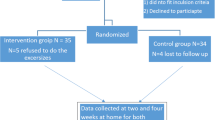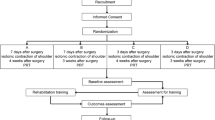Abstract
In this retrospective survey we investigated the recall of breast cancer patients (n=105) 6 months after the operation concerning postoperative instructions on exercises for shoulder mobility, and instructions for oedema prevention and treatment, upper limb strength training and the use of the upper limb in daily activities. Patients also described the content in their own words and ranked the instructors who had mostly given this education. Operation type and length of hospital stay did not have any effect on the education recalled, but the age of the respondent had some effect (r=−0.23, p<0.05). The Wilcoxon signed ranks test showed that the most commonly reported item was instructions on shoulder movements (P<0.001). Patients reported that they had more instructions for using the upper limb in daily activities than instructions for strength training (P=0.002) and oedema prevention and treatment (P=0.001). Patients own comments were sometimes conflicting: “Use the upper limb as before and you can even lift weights” and “You cannot drive a car or lift a weight over 3 kg for 6 weeks”. Over half of the respondents named the physiotherapist or physiotherapy assistant as the person who had given them most of the instructions. A medical doctor was ranked in first place by 19% of the patients. Only half of the patients reported that they had some education after hospitalization. This study suggests that postoperative education of breast cancer patients is inconsistent and insufficient to provide knowledge for independent rehabilitation for future.




Similar content being viewed by others
References
Arora N, Johnson P, Gustafson D, McTavish F, Hawkins R, Pingree S (2002) Barriers to information access, perceived health competence, and psychosocial health outcome: test of a mediation model in a breast cancer sample. Patient Educ Couns 47:37–46
Backman M, Westman M (2001) Kontinuerlig utvärdering av kvaliteten i vården utgående från patienternas uppfattning. Hoitotiede 13:52–59
Bakker D, Fitch M, Gray R, Reed E, Bennett J (2001) Patient-health care provider communication during chemotherapy treatment: the perspectives of women with breast cancer. Patient Educ Couns 43:61–71
Boman L, Björvell H, Cedermark B, Theve N, Wilking N (1993) Effects of early discharge from hospital after surgery for primary breast cancer. Eur J Surg 159:67–73
Boman L, Andersson J-U, Björvell H (1997) Needs as expressed by women after breast cancer surgery in the setting of a short hospital stay. Scand J Caring Sci 11:25–32
Bonnema J, van Wersch A, van Geel A, Pruyn J, Schmitz P, Paul M, et al (1998) Medical and psychosocial effects of early discharge after surgery for breast cancer: randomised trial. BMJ 316:1267–1271
Bosompra K, Ashikaga T, O’Brien P, Nelson L, Skelly J, Beatty D (2002) Knowledge about preventing and managing lymphedema: a survey of recently diagnosed and treated breast cancer patients. Patient Educ Couns 47:155–163
Bundred N, Maguire P, Reynolds J, Grimshaw J, Morris J, Thomson L, et al (1998) Randomised controlled trial of effects of early discharge after surgery for breast cancer. BMJ 317:1275–1279
Courneya KA, Friedenreich C (1999) Utility of the theory of planned behavior for understanding exercise during breast cancer treatment. Psychooncology 8:112–122
Courneya KS, Mackey J, Bell G, Jones L, Field C, Fairey A (2003) Randomized controlled trial of exercise training in postmenopausal breast cancer survivors: cardiopulmonary and quality of life outcomes. J Clin Oncol 21:1660–1668
Finnish Cancer Registry (2002) Cancer in Finland in 1999. Institute for Statistical and Epidemiological Cancer Research, Finland. http://www.cancerregistry.fi
Gaskin T, LoBuglio A, Kelly P, Doss M, Pizitz N (1989) STRETCH: a rehabilitation program for patients with breast cancer. South Med J 82:467–469
Hicks C (1995) Research for physiotherapists, project design and analysis. Churchill Livingstone, London, pp 150–153
Johansson K, Ingvar C, Albertsson M, Ekdahl C (2001) Arm lymphoedema, shoulder mobility and muscle strength after breast cancer treatment—a prospective 2-year study. Adv Phys 3:55–66
Kärki A, Simonen R, Mälkiä E, Selfe J (2001) Efficacy of physical therapy methods and exercise after a breast cancer operation: a systematic review. Crit Rev Phys Rehabil Med 13:159–190
Knapp T, Brown J (1995) Focus on psychometrics, ten measurement commandments that often should be broken. Res Nurs Health 18:465–469
Lavery J, Clarke V (1996) Causal attributions, coping strategies, and adjustment to breast cancer. Cancer Nurs 19:20–28
Lerman C, Daly M, Walsh W, Resch N, Seay J, Barsevick A, et al (1993) Communication between patients with breast cancer and health care providers. Cancer 72:2612–2620
Logan V (1995) Incidence and prevalence of lymphedema: a literature review. J Clin Nurs 4:213–219
Loveys B, Klaich K (1991) Breast cancer: demands of Illness. Oncol Nurs Forum 18:75–80
MacVicar M, Winningham M, Nickel J (1989) Effects of aerobic interval training on cancer patients’ functional capacity. Nurs Res 38:348–351
Markiewitcz D, Schultz D, Haas J, Harris E, Fox K, Glick J, et al (1996) The effects of sequence and type of chemotherapy and radiation therapy on cosmesis and complications after breast conservation therapy, Int J Radiat Oncol Biol Phys 35:661–668
McKenzie D, Kalda A (2003) Effects of upper extremity exercise on secondary lymphedema in breast cancer patients: a pilot study. J Clin Oncol 21:463–466
Mesters I, van den Borne B, De Boer M, Pruyn J (2001) Measuring information needs among cancer patients. Patient Educ Couns 43:253–262
Mock V, Burke M, Sheehan P, Creaton E, Winningham M, McKenney-Tedder S, et al (1994) Nursing rehabilitation program for women with breast cancer receiving adjuvant chemotherapy. Oncol Nurs Forum 21:899–907
Mock V, Dow K, Meares C, Grimm P, Dienemann J, Haisfield-Wolfe M, et al (1997) Effects of exercise on fatigue, physical functioning, and emotional distress during radiation therapy for breast cancer. Oncol Nurs Forum 24:991–1000
Mock V, Pickett M, Ropka M, Muscari E, Stewart K, Rhodes V, et al (2001) Fatigue and quality of life outcomes of exercise during cancer treatment. Cancer Pract 9:119–127
Mok E (2001) Empowerment of cancer patients: from a Chinese perspective. Nurs Ethics 8:69–76
Munro B (ed) (2001) Statistical methods for health care research. Lippincott, New York, pp 68–70, 84–161, 237
Norum J, Grev A, Moen M-A, Balteskard L, Holthe K (2003) Information and communication technology (ICT) in oncology. Patients’ and relatives’ experiences and suggestions. Support Care Cancer 11:286–293
Poole K (1996) The evolving role of the clinical nurse specialist within the comprehensive breast cancer centre. J Clin Nurs 5:341–349
Rees C, Bath P (2000) The information needs and source preferences of women with breast cancer and their family members: a review of the literature published between 1988–1998. J Adv Nurs 31:833–841
Royak-Schaler R (1991) Psychological processes in breast cancer: a review of selected research. J Psychosoc Oncol 9:71–89
Schwartz A (1999) Fatigue mediates the effects of exercise on quality of life. Qual Life Res 8:529–538
Sudgen E, Rezvani M, Harrison J, Hughes L (1998) Shoulder movements after the treatment of early stage breast cancer. Clin Oncol 10:173–181
Suominen T (1992) Breast cancer patients’ opportunities to participate in their care. Cancer Nurs 15:68–72
Suominen T, Laippala P (1993) Breast cancer patients, the support given by nurses. Scand J Caring Sci 7:131–134
Suominen T, Leino-Kilpi H, Laippala P (1994) Nurses’ role in informing breast cancer patients: a comparison between patients’ and nurses’ opinions. J Adv Nurs 19:6–11
Swedborg I, Norrefalk J-R, Piller N, Åsard C (1993) Lymphedema post-mastectomy: is elevation alone an effective treatment? Scand J Rehab Med 25:79–82
Tasmuth T, von Smitten K, Hietanen P, Kataja M, Kalso E (1995) Pain and other symptoms after different treatment modalities of breast cancer. Ann Oncol 6:453–459
Tierney A, Taylor J, Closs J (1992) Knowledge, expectations and experiences of patients receiving chemotherapy for breast cancer. Scand J Caring Sci 6:75–80
Van Wersch A, Bonnema J, Prinsen B, Pryun J, Wiggers T, van Geel A (1997) Continuity of information for breast cancer patients: the development, use and evaluation of a multidisciplinary care-protocol. Patient Educ Couns 30:175–186
Wingate L (1985) Efficacy of physical therapy for patients who have undergone mastectomies. Phys Ther 65:896–900
Wingate L, Croghan I, Natarajan N, Michalek A, Jordan C (1989) Rehabilitation of the mastectomy patient: a randomized, blind, prospective study. Arch Phys Med 70:21–24
Young- McCaughan S, Sexton D (1991) A retrospective investigation of the relationship between aerobic exercise and quality of life in women with breast cancer. Oncol Nurs Forum 18:751–757
Acknowledgements
This survey was supported by the Cancer Society of Satakunta, the Health Care District of Satakunta and the Ehrnrooth Foundation.
Author information
Authors and Affiliations
Corresponding author
Rights and permissions
About this article
Cite this article
Kärki, A., Simonen, R., Mälkiä, E. et al. Postoperative education concerning the use of the upper limb, and exercise and treatment of the upper limb: cross-sectional survey of 105 breast cancer patients. Support Care Cancer 12, 347–354 (2004). https://doi.org/10.1007/s00520-004-0612-7
Received:
Accepted:
Published:
Issue Date:
DOI: https://doi.org/10.1007/s00520-004-0612-7




